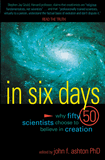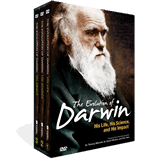Exposing a Fundamental Compromise
Some respected Christian leaders, famous for defending the fundamentals of the faith against compromise, were guilty of their own compromise.
For thousands of years Christians have faced the danger of being deceived by Satan (2 Corinthians 11:3). Sometimes in the process of defending the Christian faith, respected Christian leaders have unknowingly compromised with error.
Surprising examples include founders of modern fundamentalism.
The Fundamentalist-Modernist Controversy
At the turn of the twentieth century, a wave of liberal theology was sweeping through churches worldwide. To fight back, a group of stalwart Christians wrote what are widely considered the founding documents of modern fundamentalism. From 1910 to 1915 they published ninety articles in twelve volumes, collectively known as The Fundamentals: A Testimony to the Truth. The aim was to defend the most basic and foundational doctrines of biblical Christianity.
In total, three million copies of the volumes were eventually distributed free of charge to church leaders throughout the English-speaking world.
The authors were selected by a committee of some of the most doctrinally sound men of the day under a succession of godly editors. The third and final editor, R. A. Torrey, was a close associate of evangelist D. L. Moody and the second president of what became Moody Bible Institute. The evangelical authors hailed from America, Canada, and Great Britain and represented diverse denominations—Baptists, Anglicans, Presbyterians, Methodists, and Congregationalists.
Most articles were sound and are still well worth reading, but the six articles on the early chapters of Genesis and science must be read with care. Two of these articles helpfully contend that evolution is contrary to Scripture.1 But two other articles that oppose atheistic evolution and human evolution do not clearly oppose the compromise idea of theistic (God-directed) evolution. Worse yet, three of the six clearly accept the claim of evolutionary geologists about history over millions of years. None of the six articles takes a stand for the clear biblical teaching of a literal six-day creation a few thousand years ago.
Scottish Theologian James Orr
Scottish theologian James Orr (1844–1913) provides helpful articles about Christ’s virgin birth and other doctrines. At first glance, his article on “The Early Narratives of Genesis” appears sound, too. He contends that Genesis 1 and 2 are not contradictory creation accounts, and he asserts that the Flood was a historical event. But he does not explicitly discuss the age of the earth, and he is not clear whether the Flood was global. Hinting at his compromise views, he asserts, “The Bible does not teach modern science” (p. 81).2
In a later article on “Science and Christian Faith,” his compromise is revealed. He tells us that geology has “expanded our ideas of the vastness and marvel of the Creator’s operations through the aeons of time” and if we accept the creation days as “aeonic days—vast cosmic periods, . . . then the last trace of apparent conflict disappears” (pp. 133–134). He obviously felt he could say this because he mistakenly asserted that the order of events in Genesis 1 fit “the broad facts even of geological succession.”3
Canadian Theologian Dyson Hague
The prominent Canadian theologian, Dyson Hague (1857–1935), rightly asserts in his article, “The Doctrinal Value of the First Chapters of Genesis,” that Genesis is foundational to the rest of the Bible. He insists on the “historicity of Genesis and its Mosaic authorship” (p. 102) and that Genesis “has no doctrinal value if it is not authoritative” (pp. 103). He affirms a literal Adam and the historical fall of Adam into sin as the foundation of the Bible’s teaching on redemption.
But Hague unintentionally starts to undermine even his own affirmation of the truth and authority of Genesis when he says that “Genesis is admittedly not a statement of scientific history” (p. 107).
Like Orr, he mistakenly asserts that the order of events in Genesis and the old-earth geological theory are wonderfully compatible because he ignores some of the details of Genesis 1 and leaves the creation of stars out of the picture. He concludes that we should “take our stand with” Georges Cuvier, J. William Dawson, and James Dana, who were all old-earth proponents. Dana, a geologist who leaned toward theistic evolution, taught that Genesis is “in perfect accord with known science” (p. 114).
American Theologian George Frederick Wright
An American Congregationalist theologian, George Frederick Wright (1838–1921) contributed an article that boldly defends Moses’s authorship of the first five books of the Bible. But then his article on “The Passing of Evolution” startles the reader with these words, “The Bible, indeed, teaches a system of evolution” and explains his view that the orderly progress of the days of creation in Genesis 1 (“whatever period ‘day’ may signify”) is “from lower to higher forms of matter and life” (p. 613).
He later clarifies, however, that by “evolution” and “progress” he does not mean what Darwinists mean. Noting that Genesis records the creation of plants and animals “after their kind,” he rejects the notion of microbes-to-man evolution, chemical evolution of life from non-living matter, and the evolution of man from nonhumans. He even affirms that Adam and Eve “came into existence as the Bible represents, by the special creation of a single pair” (p. 623).
Sadly, none of these men discussed the relevant scriptures. For them “geology had spoken” and the Bible was silent on the matter.
Wright concludes that evolution is not proven despite the efforts of atheistic and deistic evolutionists, and those efforts cannot banish the idea that God designed the creation. But he confusingly makes a vague comment about “prehistoric man” and “higher animals associated with him in later geological ages” (p. 623). When discussing the contemporary geologists’ estimate of 350 million years and Lord Kelvin’s estimate of 30 million years for the age of the earth, Wright appears to be content with the latter age but offers no comments about the Bible’s teaching on the subject.
Sadly, none of these articles really discusses any of the Scriptures in Genesis relevant to the question of the earth’s age or the extent and character of Noah’s Flood. Yet all our efforts to find truth and understand the world must begin with Scripture. For these men “geology had spoken” and the Bible was silent on the matter—a remarkable perspective in a book intent on defending the truth of the Bible.
Lead Editor R. A. Torrey
None of this confusion and compromise is surprising when we learn that Torrey (1856–1928), one of the lead editors of The Fundamentals, studied geology under the theistic evolutionist and uniformitarian James Dwight Dana. Torrey accepted earth history over millions of years, reinterpreted the days of creation as long ages, and believed there was a great gap of time between Genesis 1:1 and 1:2. Although he rejected human evolution, he did believe in the existence of pre-Adamite humans.4
Sadly, The Fundamentals’ influence on the teaching of Christian colleges and seminaries—which produced the pastors, missionaries, theologians, and college presidents of the next generation—is impossible to overstate.
The Fundamentals were published on the heels of the immensely influential Scofield Reference Bible (1909), which also led the church astray with its brief marginal note on Genesis 1:2. Scofield wrote, “The first creative act refers to the dateless past, and gives scope for all the geologic ages. . . . Relegate fossils to the primitive creation, and no conflict of science with the Genesis cosmogony remains.”
But these early twentieth-century evangelical men are part of a long line of otherwise godly, Bible-believing Christian leaders and scholars who have mistakenly believed that geologists have proven that the earth is millions of years old.
The compromise started in the early nineteenth century, with men like Thomas Chalmers.5 It has continued increasingly into the present, through the influence of countless evangelical scholars and leaders, including Charles Spurgeon, Charles Hodge, B. B. Warfield, William Jennings Bryan, James Montgomery Boice, Gleason Archer, Bill Bright, Norman Geisler, William Lane Craig, J. P. Moreland, Billy Graham, Bruce Waltke, and Tim Keller, some of whom have even embraced theistic evolution.6
Ironically, James Orr’s article on “Science and the Christian Faith” rebukes past Christians for distrusting geology because they feared that its pronouncements on earth history conflicted with Scripture. Yet his words describe precisely what he and other fundamentalists were doing: “It is an unhappy illustration of how the best of men can at times err in matters which they imperfectly understand, or where their prejudices and traditional ideas are affected” (p. 126).
The theological inconsistencies of these respected leaders warn us about the ever-present danger of trusting men and movements rather than the clear revelation of Scripture. All men have feet of clay (in fact, God says we are all 100% clay—Isaiah 64:8). That’s why believers must remain vigilant, never wavering from their firm stand on God’s Word, no matter how unpopular that stand may be.
None of us, including any particular scholar (no matter how respected he is), or even the majority of scholars or Christians, can be the final authority for determining truth. God’s Word must be the authority. And it clearly teaches creation in six literal days about six thousand years ago and a global catastrophic Flood at the time of Noah. We must graciously but uncompromisingly contend for the literal historical truth of Genesis 1–11, which is absolutely fundamental to all other doctrines in the Bible.
While it is discouraging to see how the error of a few can impact so many millions, the voice of even a few faithful Christians can make just as great an impact. It starts with each of us, and those we directly influence—our children, our church friends, and any other sincere seeker of truth that God brings across our path. By God’s grace, we can make a difference!
Related Videos
Christian Compromises With Old-Earth Geological Theories
Answers Magazine
July – September 2010
From subtropical Madagascar to Antarctica, from frozen deserts to poisonous submarine volcanoes, creatures seem to inhabit every corner of the globe. How can they survive so well under so many different conditions? This issue includes a special section that examines life at the extremes, where God’s creative power continues to astound and delight us!
Browse Issue SubscribeFootnotes
- Anon., “Evolutionism in the Pulpit” and Henry H. Beach, “The Decadence of Darwinism” in The Fundamentals, ed. R. A. Torrey, http://fundamentalists.whybaptist.com/index.aspx.
- All page references are from R. A. Torrey, ed., The Fundamentals (Grand Rapids, Michigan: Kregel, 1990), a reprint of 68 of the 90 articles.
- Orr was not well informed on this matter. The order of creation in Genesis 1 did not match the order that creatures appeared in the geological record. This was the case in the early nineteenth century (when the idea of millions of years of history was developed) and in Orr’s day, and it is still the case today. See Terry Mortenson, “Evolution vs. Creation: the Order of Events Matters!” https://answersingenesis.org/why-does-creation-matter/evolution-vs-creation-the-order-of-events-matters/, April 4, 2006.
- David N. Livingstone, Darwin’s Defenders (Grand Rapids, Michigan: Eerdmans, 1987), pp. 151–152.
- See Terry Mortenson’s 2-part, 2-hour DVD lecture, “The Origin of Old-Earth Geology and Christian Compromise in the Early Nineteenth Century” (Petersburg, Kentucky: Answers in Genesis, 2003). A one-hour version is “Millions of Years: Where Did the Idea Come From?” (Petersburg, Kentucky: Answers in Genesis, 2005). Mortenson’s PhD research behind these lectures is presented in The Great Turning Point: The Church’s Catastrophic Mistake on Geology—Before Darwin (Green Forest, Arkansas: Master Books, 2004).
- See Terry Mortenson, “Christian Leaders and Scholars on Genesis 1–11,” http://www.answersingenesis.org/go/believe-genesis.
Recommended Resources

Answers in Genesis is an apologetics ministry, dedicated to helping Christians defend their faith and proclaim the good news of Jesus Christ.
- Customer Service 800.778.3390
- © 2024 Answers in Genesis






